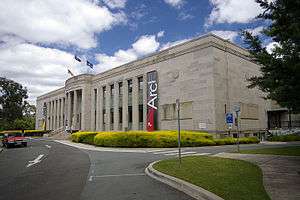Australian Institute of Anatomy
The Australian Institute of Anatomy was established in October 1931. Its functions included a natural history museum and research in human nutrition. The Institute was formally abolished in December 1985.[1]
History of the building

Now occupied by the National Film and Sound Archive, the building was the home of the Australian Institute of Anatomy from 1931-84. Originally it held the anatomy collection of Sir Colin MacKenzie. This collection included the heart of the celebrated Australian racehorse Phar Lap. Professor Sir Colin MacKenzie became the founding director of the Institute on Anatomy, and on his death in 1938 his ashes were placed behind a commemorative plaque in the building’s foyer. According to the Register of the National Estate, buildings constructed during this phase were ‘built to broaden national interest and establish the city as a centre of archives and collections’.
Both grand and austere, the building is often classified as art deco, though its overall architectural style is technically Stripped Classical, the style of ancient Greece and Rome but simplified and modernised. Classical architecture was popular during the 1930s and 1940s but lost favour after the downfall of Germany’s Third Reich. The style was again revived in the early 1960s and became common for government buildings in Canberra during this time. Examples include the Law Courts of the ACT (1961) and the National Library of Australia (1968).
Buildings in this style often feature a symmetrical façade, a horizontal skyline, classical columns and a central entrance. Traditional building materials such as stone and terracotta are often employed. The building characterises what the Register of the National Estates has described as ‘some of the finest examples of nationalistic Australian Art Deco design and detailing in Australia.’ The art deco influence is evident in the strong and consistent decorative features of native flora, fauna and Aboriginal art and motifs throughout the building.
The entrance features a curved central bay decorated with goannas, ferns and waratahs. The entrance door itself has a carved stone surround of open-mouthed frilled lizards framed in triangles. Tiled panels beneath the windows at the front of the building have blue and green motifs which resemble Aboriginal bark paintings. The foyer’s beautiful interior features a geometrically patterned marble floor. The black marble in the floor was quarried from the Acton Peninsula, now submerged beneath Lake Burley Griffin. The foyer also features a stained-glass platypus skylight. Face masks of well-known scientists of the era are featured on the foyer’s walls as a reminder of its previous incarnation as the Institute of Anatomy. Beyond the foyer is a tranquil landscaped courtyard. Each side of the courtyard features carved wombat heads over the main arches. The courtyard leads to two galleries which now hold fascinating exhibitions.
The original part of the building has a theatre and research centre. Each area is decorated in geometric art deco patterns, a feature repeated throughout the building in its doors, ventilators and light fittings. The theatre was the meeting place for one of Australia’s pioneering film societies in the 1930s—the Canberra Film Society.
In 1984 it became the home of the newly created National Film and Sound Archive. Every effort has been made to retain the heritage aspects of the building in its use as a modern archive.
Building Extensions
In 1999, with the National Film and Sound Archive, its then occupant, needing additional space, the building’s large triple-level rear wing was opened. This new wing’s design is in keeping with the Art Deco style of the main structure with details and finishes to match the original.
Today, the building is open to the public as a treasure house of Australian film, television and sound recordings.
The Scientists
The foyer walls feature 12 scientists (two of which are death masks):
| Name | Lifetime | Nationality & profession |
|---|---|---|
| Sir Harry Brookes Allen | 1854 – 1926 | Australian pathologist |
| John Bell | 1763 – 1820 | Scottish anatomist |
| Charles Darwin | 1809 – 1882 | English naturalist |
| George Britton Halford | 1824 – 1910 | Anglo-Australian anatomist and physiologist |
| William Harvey | 1578 – 1657 | English anatomist |
| John Hunter | 1728 – 1793 | Scottish surgeon |
| Jean-Baptiste Lamarck | 1744 – 1829 | French naturalist |
| Joseph Lister | 1827 – 1912 | English surgeon |
| Louis Pasteur | 1822 – 1895 | French microbiologist and chemist |
| Sir James Young Simpson | 1811 – 1870 | Scottish obstetrician and anaesthetist |
| Sir Edward Charles Stirling | 1848 – 1919 | Australian surgeon |
| Sir Thomas Anderson Stuart | 1856 – 1920 | Scots-Australian physiologist |
Notes
References
- Australian Science at Work: Corporate Entry Accessed: 2008-04-21
- Charlton, K., Garnett, R., & Dutta, S., (2001), Federal Capital Architecture Canberra 1911–1939, National Trust of Australia, ACT, Australia.
Other sources
Coordinates: 35°16′59″S 149°07′16″E / 35.283°S 149.121°E